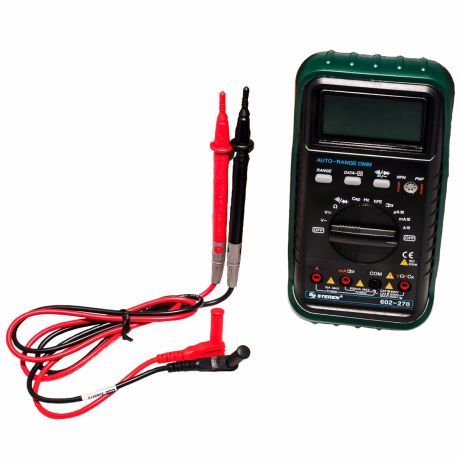Digital Auto Range Multimeter - 13 Position
| Quantity Discount Pricing | ||||
|---|---|---|---|---|
| 1-5 | 6-9 | 10-14 | 15-19 | 20+ |
| $68.99 | $66.99 | $64.99 | $62.99 | $59.99 |
Quantity Available: 4
Digital Auto Range Multimeter - 13 Position
With a 3 ¾ digit LCD display the Digital Auto Range Multimeter will give you a precise reading for electrical testing. This Multimeter tests AC/DC voltage and current, resistance, capacitance, frequency and diode continuity. The Digital Auto Range Multimeter is auto-range which means it's a hassle free way to automatically set the meter to the correct value for the desired function. It also displays analog measure bars which gives a better accuracy so you can trust the reading on this multimeter. The LCD screen is large and the multimeter is easy to use.
Features:
- 3¾ digit DMM
- 13 position rotary range
- Includes 9V battery
- Includes 3€™ double-insulated test leads
- Includes a protective holster
- 3260 counts
 WARNING: This product can expose you to chemicals including phthalates, which is known to the State of California to cause cancer and birth defects or other reproductive harm. For more information, go to www.p65warnings.ca.gov
WARNING: This product can expose you to chemicals including phthalates, which is known to the State of California to cause cancer and birth defects or other reproductive harm. For more information, go to www.p65warnings.ca.gov
Q: How should I decide what meter to buy?
A: You must first decide what you need it for. Choosing a multimeter depends on what tests you want to run and what level of power or voltage your test will need to accommodate.
Q: What are the basic things a multimeter measures?
A: Voltage Current and Resistance
Q: What is the difference between auto-ranging and manual ranging multimeters?
A: Manual range meters offer a different value range for each measurement function. They are a little more involved than an Auto range multimeter because you have to choose the range. An Auto-range multimeter automatically chooses the appropriate range when you switch the dial to the measurement function you want.
Q: Why would I have more than one multimeter?
A: A lot of times you want to measure current and voltage at the same time and you need two meters to do so. Having two meters can also help keep the meters up to date in regards to accuracy. You can compare them once in a while to see if either of the meters has drifted.
Q: How do I know my multimeter is safe for my usage?
A: If you are dealing with battery-powered 9-volt circuits or something similar an economic meter will be a sufficient choice. However if you are dealing with high voltage or high power related tests you want to step up to a more professional meter. It could be very dangerous to work with an economic meter on high power jobs.
Q: What kind of test leads should I use with my multimeter?
A: Test leads are just as important as the multimeter itself. The economic test leads will be suitable for lower power related tests. If you are going to be dealing with high voltage it is important to have good professional-grade leads. Make sure that the probes have finger guards to keep you from slipping and touching the metal. Good quality test leads will have high voltage insulation. Another feature to include on high voltage testing is shrouded banana probes so that there is no way you can touch any exposed metal.
Q: How is accuracy determined?
A:
Counts | Digits | % Accuracy |
2000 | 3 ½ | 0.5% |
3000 | 0.33% | |
4000 | 0.25% | |
6000 | 3 ¾ | 0.17% |
10000 | 0.1% | |
20000 | 4 ½ | 0.05% |

